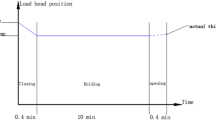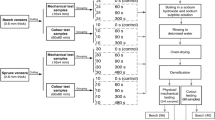Abstract
Densification and thermal modification change wood properties in different ways depending on the treatment conditions and the wood species. In the presented investigations, densification and thermal modification were applied consecutively. The primary objective of this treatment combination was the compensation of reduced mechanical properties due to the thermal modification by densification. The combined processes were applied to five European wood species: poplar (Populus nigra L.), beech (Fagus sylvatica L.), Norway spruce (Picea abies Karst.), English oak (Quercus robur L.) and European ash (Fraxinus excelsior L.). Depending on the mean density of the species, a thermo-mechanical densification of 43 or 50% was imposed to improve mechanical strength parallel to the grain. Subsequently, the densified material was thermally modified in the so-called Vacu3-process at 230 °C and 20 or 80% vacuum and at 240 °C and 20% vacuum. The thermal modification resulted in changing wood colour, mechanical strength, hardness, dimensional stability and durability. All the wood modification processes were carried out at industrial scale after pre-tests at laboratory scale. The modified material was characterized regarding flexural properties, static and dynamic hardness, structural integrity, abrasion resistance, moisture dynamics, dimensional stability, and durability against white, brown and soft rot fungi. In summary, the test results showed that the consecutive application of thermo-mechanical densification and thermal modification leads to significantly improved durability whilst mechanical properties at least for beech, ash and poplar remained and the material is dimensionally stable.




Similar content being viewed by others
References
Bekhta P, Niemz P (2003) Effect of high temperature on the change in color, dimensional stability and mechanical properties of spruce wood. Holzforschung 57:539–546
Blomberg J, Persson B, Blomberg A (2005) Effects of semi-isostatic densification of wood on the variation in strength properties with density. Wood Sci Technol 39:339–350
Bravery AF (1979) A miniaturised wood-block test for the rapid evaluation of preservative fungicides. Proceedings of a special seminar held in association with the 10th annual meeting of the IRG, Peebles, Rep. No. 136. Swedish Wood Preservation Institute, Stockholm
Brischke C, Meyer-Veltrup L (2016) Performance of thermally modified wood during 14 years of outdoor exposure. Int Wood Prod J 7:89–95
Brischke C, Koch S, Rapp AO, Welzbacher CR (2005) Surface properties of thermally treated wood—wear, abrasion and hardness. In: Militz H, Hill C (eds) Wood modification: processes, properties and commercialisation. Proceedings of the 2nd European Conference on Wood Modification, Göttingen, Germany, 6–7 October 2005, pp 371–375
Brischke C, Rapp AO, Welzbacher CR (2006) High-energy multiple impact (HEMI)-test—part 1: a new tool for quality control of thermally modified timber. International Research Group on Wood Protection, Document No. IRG-WP-06–20346
Burmester A (1973) Effect of heat-pressure treatments of semidry wood on its dimensional stability. Holz Roh-Werkst 31:237–243
CEN/TS 15083-1 (2005) Durability of wood and wood-based products—determination of the natural durability of solid wood against wood-destroying fungi, test methods—part 1: basidiomycetes. CEN (European Committee for Standardization), Brussels
CEN/TS 15083-2 (2005) Durability of wood and wood-based products—determination of the natural durability of solid wood against wood-destroying fungi, test methods—part 2: soft rotting micro-fungi. CEN (European Committee for Standardization), Brussels
Chaouch M, Dumarçay S, Pétrissans A, Pétrissans M, Gérardin P (2013) Effect of heat treatment intensity on some conferred properties of different European softwood and hardwood species. Wood Sci Technol 47:663–673
DIN 52186 (1978) Testing of wood, bending test, Beuth Verlag GmbH, Berlin
EN 113 (1996) Wood preservatives—method of test for determining the protective effectiveness against wood destroying basidiomycetes—determination of the toxic values. CEN (European Committee for Standardization), Brussels
EN 1534 (2010) Wood flooring—determination of resistance to indentation—test method. CEN (European Committee for Standardization), Brussels
EN 350 (2016) Durability of wood and wood-based products—testing and classification of the resistance to biological agents, the permeability to water and the performance of wood and wood-based materials. CEN (European Committee for Standardization), Brussels
Hakkou M, Pétrissans M, Gérardin P, Zoulalian A (2006) Investigations of the reasons for fungal durability of heat-treated beech wood. Polym Degrad Stab 91:393–397
Haller P, Wehsener J (2004) Festigkeitsuntersuchungen an Fichtenpressholz (FPH) (Mechanical properties of densified spruce) (In German). Holz Roh-Werkst 62:452–454
Heger F, Groux M, Girardet F, Welzbacher C, Rapp AO, Navi P (2004) Mechanical and durability performance of THM-densified wood. In: Proceedings of the Final Workshop of COST Action E 22, 22–23 March 2004, Estoril, Portugal
Hill CA (2006) Wood modification: chemical, thermal and other processes. Wiley, Chichester
Hill CA, Ramsay J, Keating B, Laine K, Rautkari L, Hughes M, Constant B (2012) The water vapour sorption properties of thermally modified and densified wood. J Mater Sci 47:3191–3197
Inoue M, Norimoto M, Tanahashi M, Rowell RM (1993) Steam or heat fixation of compressed wood. J Wood Fiber Sci 25:224–235
ISO 5223 (1996) Test sieves for cereals. International Organization for Standardization, Geneve
Ito Y, Tanahashi M, Shigematsu M, Shinoda Y, Otha C (1998) Compressive-molding of wood by high-pressure steam-treatment. Part 1: development of compressively molded scares from thinnings. Holzforschung 52:211–216
Kariz M, Kuzman MK, Sernek M, Hughes M, Rautkari L, Kamke FA, Kutnar A (2017) Influence of temperature of thermal treatment on surface densification of spruce. Eur J Wood Prod 75:113–123
Kollmann FP (1936) Technologie des Holzes (Technology of wood) (In German). Springer, Berlin
Korkut S, Akgül M, Dündar T (2008) The effects of heat treatment on some technological properties of Scots pine (Pinus sylvestris L.) wood. Biores Technol 99:1861–1868
Kutnar A, Kamke FA, Sernek M (2008) The mechanical properties of densified VTC wood relevant for structural composites. Holz Roh Werkst 66:439–446
Kutnar A, Kamke FA, Sernek M (2009) Density profile and morphology of viscoelastic thermal compressed wood. Wood Sci Technol 43:57–68
Laine K, Rautkari L, Hughes M (2013) The effect of process parameters on the hardness of surface densified Scots pine solid wood. Eur J Wood Prod 71:13–16
Laine K, Segerholm K, Wålinder M, Rautkari L, Hughes M (2016) Wood densification and thermal modification: hardness, set-recovery and micromorphology. Wood Sci Technol 50:883–894
Lamason C, Gong M (2007) Optimization of pressing parameters for mechanically surface-densified aspen. Forest Prod J 57:64–68
Metsä-Kortelainen S, Paajanen L, Viitanen H (2011) Durability of thermally modified Norway spruce and Scots pine in above-ground conditions. Wood Mat Sci Eng 6:163–169
Meyer L, Brischke C, Welzbacher CR (2011) Dynamic and static hardness of wood: method development and comparative studies. Int Wood Prod J 2:5–11
Meyer-Veltrup L, Brischke C, Alfredsen G, Humar M, Flæte P-O, Isaksson T, Larsson Brelid P, Westin M, Jermer J (2017) The combined effect of wetting ability and durability on outdoor performance of wood: development and verification of a new prediction approach. Wood Sci Technol 51(3):615–637
Militz H (2002) Heat treatment of wood: European Processes and their background. Document No. IRG/WP 02–40241. The International Research Group on Wood Preservation, Cardiff, Wales
Navi P, Heger F (2004) Combined densification and thermo-hygro-mechanical processing of wood. MRS Bull 29:332–336
Olek W, Majka J, Czajkowski Ł (2013) Sorption isotherms of thermally modified wood. Holzforschung 67:183–191
Rautkari L, Laine K, Kutnar A, Medved S, Hughes M (2013) Hardness and density profile of surface densified and thermally modified Scots pine in relation to degree of densification. J Mater Sci 48:2370–2375
Sandberg D, Haller P, Navi P (2013) Thermo-hydro and thermo-hydro-mechanical wood processing: an opportunity for future environmentally friendly wood products. Wood Mat Sci Eng 8:64–88
Sell J (1997) Eigenschaften und Kenngrößen von Holzarten (Properties and characteristic variables of wood species) (In German). 4th edn. Baufachverlag Lignum, Zürich
Stamm AJ, Burr HK, Kline AA (1946) Staybwood. Heat-stabilized wood. Ind Eng Chem 38:630–634
Tjeerdsma BF, Boonstra M, Pizzi A, Tekely P, Militz H (1998) Characterisation of thermal modified wood: molecular reasons for wood performance improvement. CPMAS 13C NMR characterisation of thermal modified wood. Holz Roh-Werkst 56:149–153
Van Acker J, De Windt I, Li W, Van den Bulcke J (2014) Critical parameters on moisture dynamics in relation to time of wetness as factor in service life prediction. International Research Group on Wood Protection, Document No. IRG-WP-14-20555
Vorreiter L (1958) Holztechnologisches Handbuch Band 2: System Holz-, Wasser-, Wärme, Holztrocknung, Dämpfen und Kochen. Spanlose Holzverformung (Handbook of wood technology, vol. 2) (In German). Verlag Georg Fromme & Co, Wien & München
Wehsener J, Weser T, Haller P, Diestel O, Cherif C (2014) Textile reinforcement of multidimensional formable wood. Eur J Wood Prod 72(4):463–475
Welzbacher CR, Brischke C, Rapp AO (2007) Influence of treatment temperature and duration on selected biological, mechanical, physical and optical properties of thermally modified timber. Wood Mater Sci Eng 2:66–76
Welzbacher CR, Wehsener J, Rapp AO, Haller P (2008) Thermo-mechanical densification combined with thermal modification of Norway spruce (Picea abies Karst) in industrial scale-dimensional stability and durability aspects. Holz Roh-Werkst 66:39–49
Welzbacher CR, Rassam G, Talaei A, Brischke C (2011) Microstructure, strength and structural integrity of heat-treated beech and spruce wood. Wood Mat Sci Eng 6:219–227
Acknowledgements
The authors gratefully acknowledge the financial support from German Federal Ministry of Education and Research for the Leading-Edge Cluster BioEconomy project VP 1.11—DURAPRESSTIMBER under grant number 031A440A to 031A440D. The authors also thank the partners from industry Deutsche Holzveredelung Schmeing GmbH & Co. KG—Kirchhundem, timura Holzmanufactur GmbH - Rottleberode and terHürne GmbH & Co. KG—Südlohn for collaboration. Jonas Klinger and Ann-Marie Rothschuh are acknowledged for their help with physical and mechanical experiments.
Author information
Authors and Affiliations
Corresponding author
Rights and permissions
About this article
Cite this article
Wehsener, J., Brischke, C., Meyer-Veltrup, L. et al. Physical, mechanical and biological properties of thermo-mechanically densified and thermally modified timber using the Vacu3-process. Eur. J. Wood Prod. 76, 809–821 (2018). https://doi.org/10.1007/s00107-017-1278-4
Received:
Published:
Issue Date:
DOI: https://doi.org/10.1007/s00107-017-1278-4




